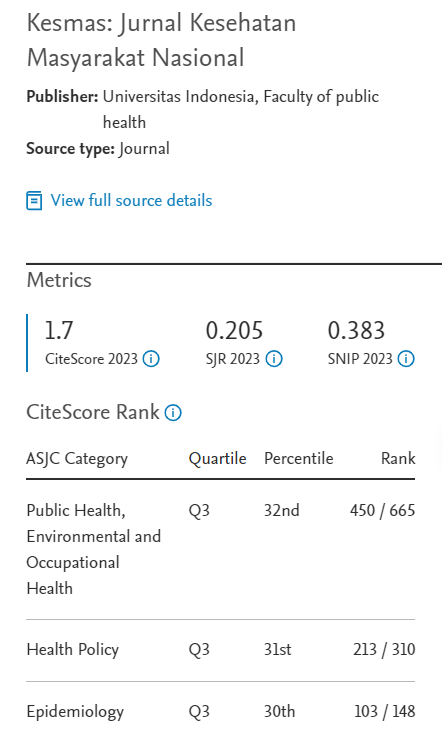Abstract
Data-data di rumah sakit maupun di masyarakat menunjukkan penyakit kardiovaskuler yang terdiri dari penyakit jantung koroner, penyakit jantung hipertensi dan stroke adalah penyebab utama kematian pada kelompok lanjut usia. Penelitian-penelitian menunjukkan bahwa faktor yang dapat menyebabkan timbulnya penyakit kardiovaskuler tersebut adalah gangguan kadar lemak dalam darah (dislipidemia) dan obesitas sentral. Berbagai penelitian dibidang penyakit kardiovaskular telah dilakukan, tetapi data mengenai dislipidemia dan obesitas sentral pada lansia Indonesia masih dirasakan kurang. Tujuan utama penelitian ini adalah untuk mengetahui prevalensi dislipidemia dan obesitas sentral, serta faktor-faktor yang berhubungan dengan obesitas sentral pada lansia di Padang, daerah dengan prevalensi penyakit kardiovaskular yang tinggi. Suatu studi cross sectional dilakukan pada 205 lansia di kota Padang sebagai sampel, dengan menggunakan metode multistage random sampling. Pengumpulan data dilakukan dengan wawancara menggunakan kuesioner yang terstruktur, pengukuran antropometri dan tekanan darah serta analisa kadar lemak darah. Studi ini menunjukkan bahwa prevalensi dislipidemia dan obesitas sentral didapatkan cukup tinggi, masing-masing lebih dari 45% pada populasi studi. Kadar trigliserida darah diatas 200 mg/dl, dan rasio total/HDL kolesterol ≥5, meningkatkan resiko terjadinya obesitas sentral, dengan OR masing-masing 8.5 dan 3.08. Hasil ini menunjukkan bahwa pemeriksaan rutin kadar lemak darah dan pemeriksaan antropometri sederhana pada lansia perlu dilakukan sebagai pencegahan penyakit kardiovaskular.
Cardiovascular disease has become the first cause of death among elderly. Many studies on the relationship between dyslipidemia, obesity and cardiovascular disease have been done, but studies investigating prevalence of dyslipidemia and central obesity among the elderly in Indonesia are lacking. Therefore, there is an urgent need to elaborate information on dyslipidemia and central obesity in the Indonesian elderly, which will allow the policy makers to provide appropriate intervention programs against cardiovascular disease. The primary purpose of this study was to observe prevalence of dyslipidemia and central obesity, and also to find independent factors of central obesity among elderly in Padang, area with high prevalence of cardiovascular disease. A cross-sectional study was undertaken in Padang with total sample of 205 elderly using multistage random sampling. Data were collected through interview using structured questionnaires, anthropometric measurements, biochemical blood analysis, and blood pressure measurements. Prevalence of dyslipidemia (hypercholesterolemia and LDL-cholesterolemia) and ratio of total cholesterol to HDL cholesterol ≥5 found in the study was quite high, more than 50% and 45% respectively, in the study population both in elderly men and women. Prevalence of central obesity was also quite high in elderly women (46.3 %). This study showed that triglyceride level more than 200 mg/dl (OR 8.5) and ratio of total/HDL cholesterol ≥5 (OR 3.08) increase the risk of having central obesity 8.5 fold and 3.08 fold, respectively. Health education program to elderly group should emphasize the importance of regular check of plasma lipid and simple anthropometric measurement for early detection of cardiovascular disease risk factors.
References
- Boedhi-Darmojo R, 1996. Penelitian penyakit kardiovaskular di masyarakat pedesaan. Medika; 6:450-457.
- Guo S et al, 1999. Aging, body composition, and lifestyle: the Fels Longitudinal Study. American Journal of Clinical Nutrition; Vol. 70, No. 3, 405-411.
- Turcato et al, 2000. Waist circumference and abdominal sagittal diameter as surrogates of body fat distribution in the elderly: their relation with cardiovascular risk factors. International Journal of Obesity 24, 1005-1010.
- Kathryn et al, 1998. Abdominal Adiposity and Coronary Heart Disease in Women. JAMA;280:1843-1848.
- Marmot MG , 1993. Epidemiology of tryglicerides and coronary heart disease. Lancet ; 342 : 781 - 2.
- Baecke et al, 1982.. A short questionnaire for the measurement of habitual physical activity in epidemiological studies. Am J Clin Nutr;36:936-942
- National Cholesterol Education Program criteria modified for Asians (NCEP ATP III) Expert Panel on Detection, Evaluation, and Treatment of High Blood Cholesterol in Adults. Executive Summary of the Third Report of the National Cholesterol Education Program (NCEP) Expert Panel on Detection, Evaluation, and Treatment of High Blood Cholesterol in Adults (Adult Treatment Panel III). JAMA. 2001;285:2486 –97.
- MC Carr et al, 2004. Abdominal obesity and dyslipidemia in the metabolic syndrome: importance of type 2 diabetes and familial combined hyperlipidemia in coronary artery disease risk. J. Clin. Endocrinol. Metab.; 89(6): 2601-7.
- Huang et al, 2005. Obesity in the elderly and its relationship with cardiovascular risk factors in Taiwan. Obesity;13(1): 170-8.
- Shen et al, 2006. Waist circumference correlates with metabolic syndrome indicators better than percentage fat. Obesity; 14(4): 727-36.
- Kannel WB, 2000. Risk stratification in hypertension: new insights from the Framingham Study. Am J Hypertens;13:3S-8S.
- Zaanchetti A,1994. Hyperlipidemia in the Hypertensive patient. Am J Med; 96:3S – 8S.
- Capurso et al, 1992. Lipid control with low-dosage simvastatin in patients with moderate hypercholesterolemia. An Italian multicentre double-blind placebo- controlled study. Eur Heart J;13:11-16.
- Kamso S. Nutritional Aspects of hypertension in the Indonesian Elderly. PhD Thesis. SEAMEO-TROPMED. University of Indonesia, 2000.
Recommended Citation
Kamso S .
Dislipidemia dan Obesitas Sentral pada Lanjut Usia di Kota Padang.
Kesmas.
2007;
2(2):
73-77
DOI: 10.21109/kesmas.v2i2.274
Available at:
https://scholarhub.ui.ac.id/kesmas/vol2/iss2/5







